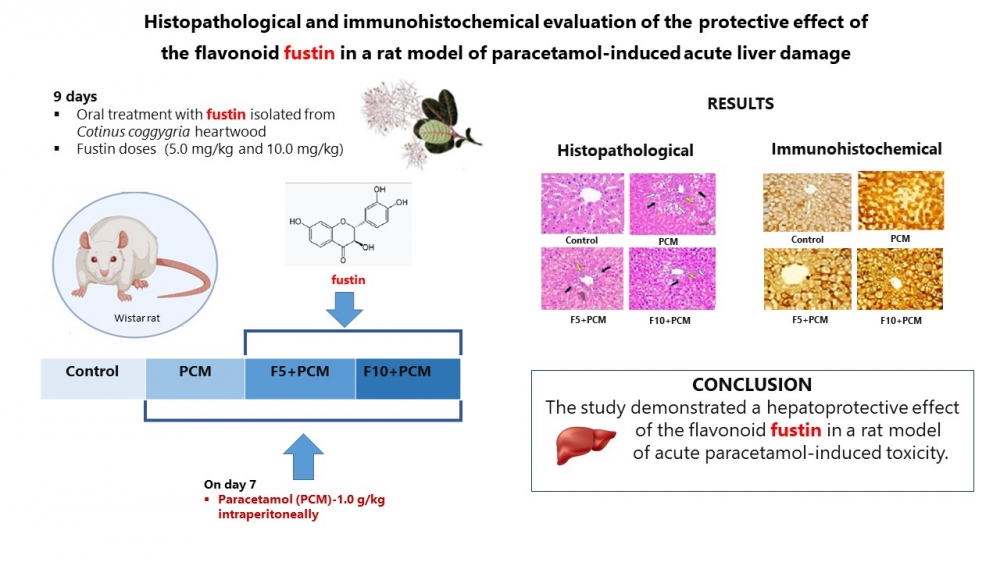JOURNAL 3060
Records of Agricultural and Food Chemistry
Year: 2024 Issue: 3 Special Issue: Abstracts 3rd. TCS, International Food Chemistry Congress February 29-March 03,2024 Antalya Türkiye
p.54 - 54
Viewed 696 times.
-
Milena Salbashian

-
Miglena Nikolova

-
Mehmed Abtulov

-
Miroslav Eftimov

-
Antoaneta Georgieva

-
Vele Tešević

-
Miroslav Novakovic

-
Danail Pavlov

-
Maria Tzaneva

-
Nadezhda Stefanova

-
Stefka Valcheva-Kuzmanova

GRAPHICAL ABSTRACT

ABSTRACT
Cotinus coggygria (smoke tree) is a medical plant with health-promoting activities proven in experimental and clinical studies. It has а high content of polyphenols, including, the dihydroflavonol fustin [1]. The aim of the present study was to evaluate the effects of the fustin, isolated from Cotinus coggygria heartwood, on the histopathological and immunohistochemical changes in the livers of rats exposed to acute PCM overdose. Male Wistar rats were allocated to four groups (n=12): Control, PCM, F5+PCM and F10+PCM. The rodents were treated daily orally for 9 consecutive days as follows: groups F5+PCM and F10+PCM – with fustin (suspended in a vehicle) at doses of 5 and 10 mg/kg, respectively; groups Control and PCM – with the vehicle. PCM was injected intraperitoneally (1.0 g/kg) on day 7. On the 10th day of the experiment, liver samples were taken and fixed in 10% buffered formalin. Later, they were embedded into paraffin wax, sliced into tiny sections of 4 µm and stained with hematoxylin and eosin and observed by light microscopy. Histopathological liver changes such as necrosis, steatosis, and ballooning degeneration as well as inflammation and cell apoptosis were scored according to a grading system. Immunohistochemical study of the expression of NF-κB was carried out using a rabbit anti-NF-kB-p100 polyclonal antibody (E-AB-32222; Elabscience, USA) by universal highly sensitive visualization system for antibody detection EnVision FLEX. The results showed that PCM induced extensive and confluent necrosis, degenerative changes of the hepatocytes predominantly in the centrilobular and partly in the intermediate zones of the liver lobules as well as increased number of apoptotic bodies. Hepatocytes with ballooning and fatty degeneration were observed in close proximity with central veins and intermediate zones. Compared to PCM group, in F5+PCM and F10+PCM groups, the liver necrosis, steatosis, ballooning degeneration and inflammation were significantly reduced. The immunohistochemical expression of NF-κB in PCM group was significantly increased (p<0.001 vs. Control). In F5+PCM and F10+PCM groups, NF-κB expression was significantly reduced (p<0.001 vs. PCM group) and localized predominantly in the sinusoids. The mechanisms behind the described hepatoprotective effect of fustin proven by histopathological and immunohistochemical stadies might be a reduction of oxidative stress and enhancement of endogenous antioxidants [2] as well as suppression of the inflammatory signaling pathway of NF-κB.
KEYWORDS
- Fustin
- liver
- paracetamol
- Cotinus coggygria